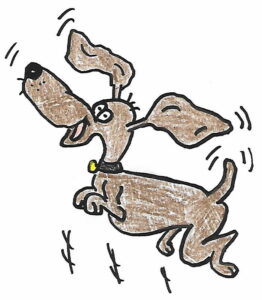Barks Blog
Partnering With the Veterinary Community
As a force-free professional dog trainer and behavior consultant I practice a holistic approach to pet care and training and have worked to develop a network of professionals in various fields who serve the needs of dog owners. These services are grooming, pet sitting, boarding, daycare, pet supplies and veterinary.

My goal is to develop a referral network with those who put the welfare of pets at the pinnacle of their business model, as I do. As a result of this strategy I enjoy referrals from about 15 veterinarians with whom I am acquainted, and am getting referrals from others I have never met.
I am sharing my tips so other force-free professionals may also develop local networks. Like tossing a stone into a pond, there is a ripple effect. Working together we can educate and inform pet owners and professionals alike, pushing aversive methods and equipment out of the consumer-service provider chain.
Veterinary professionals are sometimes asked questions about dog training and behavioral problems by their clients, yet they may have no education or experience in those fields. That, I think, would be an awkward situation. They may feel a need to respond but not know how to do so with the best information.
If there is a need for valid and safe information about dog training and behavior within the veterinary community, my goal is to fill that need. In short, I want to make their job easier and support the welfare of the pets we both care for.
First, I developed an educational presentation which I offer through the local school district community education program. School districts are often eager for community members with expertise to offer classes for public education. Perhaps your school district would offer you the same opportunity.

I call my presentation the “ABCs of Animal Training”. Topics include how to select a dog trainer, an examination of various training methods, and recommendations from professional organizations. I inform the learners so they may make better choices as pet stewards and consumers.
Second, once I polished the presentation to my satisfaction I prepared to visit veterinary clinics. I researched each clinic on their website to identify core values and branding and then sent an introductory email to them. I explained who I was, what services I offered, and why I wanted to develop a relationship with the clinic to better serve our mutual clients.
Then I explained my presentation and requested that they consider allowing me 30 minutes during one of their monthly staff meetings to provide information and materials that are recommended by resources I know they will acknowledge and respect: American Veterinary Society of Animal Behavior, American College of Veterinary Behaviorists and American Animal Hospital Association.
Thus far each clinic I approached has enthusiastically accepted my offer.
I can proceed with or without the PowerPoint presentation and prefer to speak without notes, making the presentation more conversational and organic. I bring enough portfolios for each clinic employee, and each contains a table of contents and six printed documents. Also, I provide the clinic with a DVD demonstrating my training methods.
The first chapter of the DVD explains learning theory and operant conditioning in detail, and the second chapter shows me teaching five common training skills to various dogs, from scratch. It is an excellent way to introduce force-free training to veterinary professionals and demonstrates how quick and fun the process is.
I make it easy for them to refer their clients to me, with confidence.
To create the DVD I use a Sony Camcorder and Ulead Moviefactory 6 to take video and create the media. An alternative would be to hire a local business to take care of all the nuts and bolts of video production for you.
I inject a good deal of humor into my presentation, offering analogies which the learners can relate to, and explain how different trainers would approach common training issues such as when a dog jumps on people for attention.

First I explain how a trainer who uses positive punishment/negative reinforcement would work, using a realistic stuffed dog for demonstration. Next I demonstrate how a positive reinforcement/negative punishment trainer would work with a dog. Then I ask the audience which methods are consistent with their veterinary oath.
I also throw fun pop quizzes into the presentation to keep it interactive. One of my questions is “Who can tell me what a veterinary behaviorist is?” and another is “If a trainer tells you that he/she is a “positive” trainer, what does that mean?” This keeps the learners listening and processing the information.
My training treat bag is filled with ultra-high quality chocolates and I hand them out to those who engage with me, pointing out the “positive reinforcement” of doing so. For the most difficult of my quiz questions I give away a coffee mug with my company logo on it. I ensure that everybody gets something by the end of the presentation.
In conclusion I ask whether they have learned anything helpful, and offer a generous supply of my business cards and brochures. I also explain that if a vet clinic client approaches me for help and my schedule is too busy, or the issue at hand exceeds my ability or knowledge, I maintain a list of other local force-free trainers to whom I gladly make referrals. I also discuss the Pet Professional Guild and how that is a great free resource for pet owners.

Finally, I explain my referral-and-reward program. For every new client I gain through referral, I express my thanks to the individual or clinic making the referral with an Amazon gift card. It is another way of positively reinforcing veterinary professionals for directing pet owners to force-free trainers while engaging in very effective, yet low cost marketing.
The vast majority of my new clients come from referrals, many of whom chose to avoid aversive trainers and were seeking a more humane alternative. They just needed some help in finding a force-free professional. Let’s make it easier for them.

The end result is that veterinary professionals do not feel pressured to become dog training and behavior experts. They can help pet owners by referring them to an expert who is friendly, knowledgeable and equally committed to “First, do no harm.”
Go forth, dear colleagues, and be that expert. It is a win-win situation for all involved.
(Revised 12-15-18)
RESOURCES:
American College of Veterinary Behavior. How to Hire a Dog Trainer. Retrieved from https://cdn.ymaws.com/www.dacvb.org/resource/resmgr/docs/How-to-select-a-trainer-owne.pdf
American Veterinary Society of Animal Behavior. How to Choose a Trainer. Retrieved from https://avsab.org/wp-content/uploads/2018/03/How_to_Choose_a_Trainer_AVSAB.pdf
Marcy Hammerle, DVM, DABVP (C/F), Christine Horst, DVM, Emily Levine, DVM, DACVB, MRCVS, Karen Overall, MA, VMD, PhD, DACVB, CAAB, Lisa Radosta, DVM, DACVB, Marcia Rafter-Ritchie, LVT, CPDT, VTS-Behavior, Sophia Yin, DVM, MSAAHA (2015) Canine and Feline Behavior Management Guidelines. Retrieved from https://www.aaha.org/graphics/original/professional/resources/guidelines/2015_aaha_canine_and_feline_behavior_management_guidelines_final.pdf
Pet Professional Guild (2018) The Science of Force-Free Learning: How Our Pets Learn! Retrieved from https://ppgworldservices.com/2018/03/12/the-science-of-force-free-learning-how-our-pets-learn/
Zazie Todd, PhD. (2017) Companion Animal Psychology New Literature Review Recommends Reward-Based Training. Retrieved from https://www.companionanimalpsychology.com/2017/04/new-literature-review-recommends-reward.html

